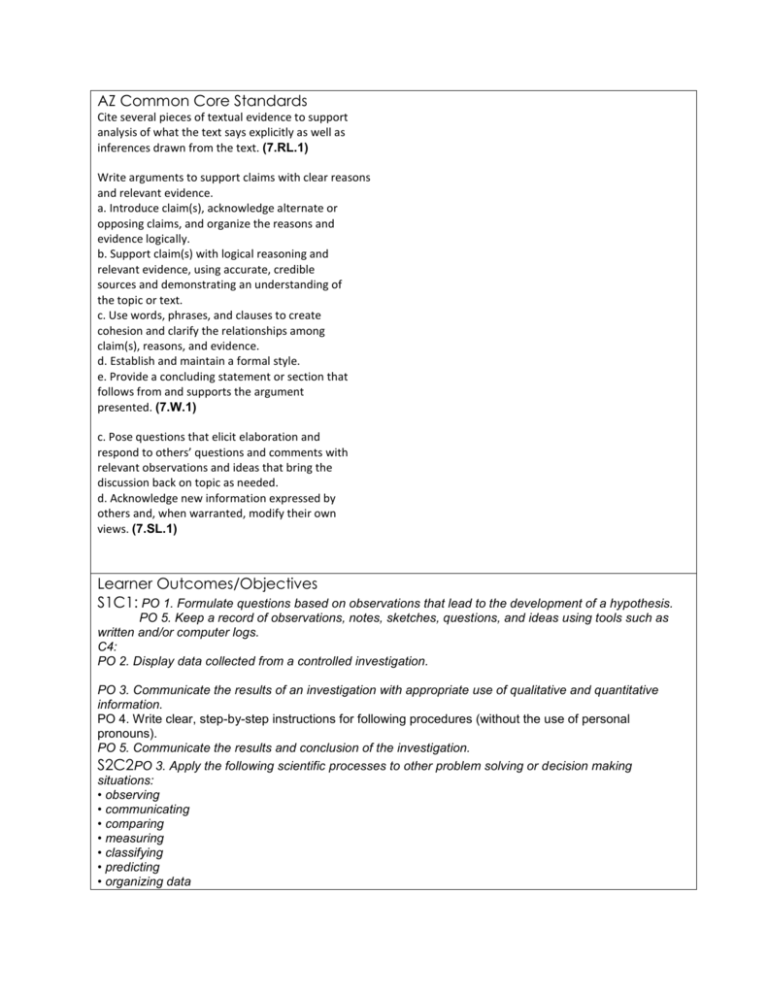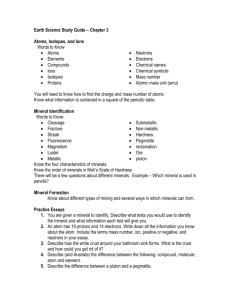Lesson Plans: Monday, September 21
advertisement

AZ Common Core Standards Cite several pieces of textual evidence to support analysis of what the text says explicitly as well as inferences drawn from the text. (7.RL.1) Write arguments to support claims with clear reasons and relevant evidence. a. Introduce claim(s), acknowledge alternate or opposing claims, and organize the reasons and evidence logically. b. Support claim(s) with logical reasoning and relevant evidence, using accurate, credible sources and demonstrating an understanding of the topic or text. c. Use words, phrases, and clauses to create cohesion and clarify the relationships among claim(s), reasons, and evidence. d. Establish and maintain a formal style. e. Provide a concluding statement or section that follows from and supports the argument presented. (7.W.1) c. Pose questions that elicit elaboration and respond to others’ questions and comments with relevant observations and ideas that bring the discussion back on topic as needed. d. Acknowledge new information expressed by others and, when warranted, modify their own views. (7.SL.1) Learner Outcomes/Objectives S1C1: PO 1. Formulate questions based on observations that lead to the development of a hypothesis. PO 5. Keep a record of observations, notes, sketches, questions, and ideas using tools such as written and/or computer logs. C4: PO 2. Display data collected from a controlled investigation. PO 3. Communicate the results of an investigation with appropriate use of qualitative and quantitative information. PO 4. Write clear, step-by-step instructions for following procedures (without the use of personal pronouns). PO 5. Communicate the results and conclusion of the investigation. S2C2PO 3. Apply the following scientific processes to other problem solving or decision making situations: • observing • communicating • comparing • measuring • classifying • predicting • organizing data • inferring • generating hypotheses • identifying variables S6C1PO 1. Classify rocks and minerals by the following observable properties: • grain • color • texture • hardness MONDAY: Students will complete part 1 of their mineral identification lab. Students will begin the process of testing mineral properties, including, streak, luster, hardness, cleavage vs. fracture, color, magnetism, reactivity to acid, and fluorescence. No HW TUESDAY: Students will complete their mineral properties identification lab by finishing their remaining stations. Students will compare their results to a dichotomous key to identify their minerals. Students should use as many properties they can compare as possible for proper identification. Homework: Students will complete the 2.2 reading worksheet and 2.1 challenge guide given to them on Friday of last week. WEDNESDAY: Students will be introduced to writing a CER for lab conclusions. Students will first make a claim (name a mineral from the lab), then support their claim with matching evidence from the lab that was measured by their group. Students will start their mineral properties foldable. Students will show several properties that can be tested and how they are, including examples of minerals within their foldables. NO HOMEWORK THURSDAY: Students will complete their mineral properties foldable discussed and started on Wednesday. This will be due on Friday. See foldable instructions link under lesson plans. Homework: Finish foldable if not done. Review sections 1 and 2, from chapter 2 (pages 4357 in the text) for tomorrow’s quiz FRIDAY: 1- Quiz: Chapter 2, sections 1 and 2: Mineral Properties 2- Chapter 2. Section 3 Reading Worksheet. Students will be introduced to minerals as resources, their uses in industry and as valuable gem stones.






